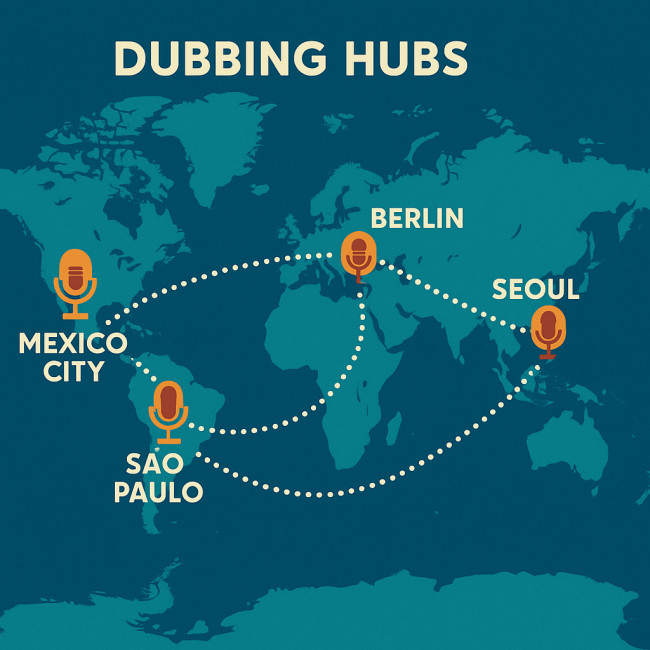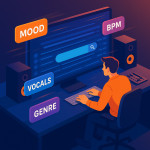Global dubbing routes: adapting vocals for multilingual soundtrack releases
Planning to launch your film, series, or game worldwide? Mastering global dubbing routes ensures your soundtrack connects with audiences from Seoul to São Paulo. This guide walks you through every phase—localisation, vocal casting, recording, post-production, and compliance—so you can adapt vocals for multilingual soundtrack releases on time and on budget.
Why multilingual dubbing is a 2025 must-have
Streaming platforms now premiere content in more than 30 territories at once. Viewers expect lip-synced speech and songs that feel native, not translated. A polished dub:
- Boosts completion rates by up to 50 % in non-English markets.
- Unlocks extra licensing revenue from airlines, broadcasters, and OTT bundles.
- Strengthens brand perception—audiences judge audio quality as a proxy for overall production value.
In short, ignoring global dubbing routes means leaving both fans and cash on the table.
Mapping global dubbing routes: where and how to record efficiently
Choosing the right studio hub for each language saves money and eliminates shipping delays. Below is a quick-glance table.
| Language Hub | Common Studio Cities | Average Turnaround | Typical Cost per Finished Minute |
|---|---|---|---|
| Latin-American Spanish | Mexico City, Bogotá | 10 days | €40 – €60 |
| French (EU) | Paris, Brussels | 8 days | €45 – €70 |
| German | Berlin, Munich | 9 days | €50 – €75 |
| Brazilian Portuguese | São Paulo, Rio de Janeiro | 11 days | €35 – €55 |
| Japanese | Tokyo, Osaka | 14 days | €55 – €85 |
Use these benchmarks when comparing bids or consulting detailed rate guides such as fair soundtrack vocal pricing.
Pre-production: shore up translation and casting before the mic opens
1. Lock an adaptive script
Provide linguists with lyric sheets, timing notes, and emotional cues. Encourage back-translations to catch cultural pitfalls early.
2. Build a native casting pool
Compile 3-5 voices per role using searchable platforms like the Artfolio soundtrack singer directory. Check vocal range, accent authenticity, and availability for pickups.
Quality voice reels matter—review audio specs in this demo optimisation guide before shortlisting.
3. Finalise technical specs
- Frame rate and loudness targets (EBU R128 or ATSC A/85)
- Preferred sample rate (48 kHz for video, 96 kHz for game engines)
- Stem naming conventions to streamline hand-offs; see layered vocal stem prep.
Recording strategies: capturing vocals that travel well
Choose a neutral chain
Condenser mics such as the Neumann TLM 103 or Sennheiser MKH 416 are global dubbing staples thanks to consistent off-axis response. Pair with transparent preamps (Grace, Avalon) to avoid colouration conflicts between languages.
Session workflow
- Run a “mumble pass” to match lip movements before full-emotion takes.
- Record room tone for each booth; it speeds automated dialogue replacement (ADR) edits.
- Capture wild lines for unpredictable SFX moments—shouted commands, distant calls, etc.
Remote or on-site?
In 2025, 38 % of dubbing projects mix remote and studio sessions. Factor in:
- Latency—ensure round-trip under 50 ms using Source-Connect Now or Audiomovers.
- Backup power and local recorded stems as fail-safe.
- Union rules—remote work may still require a studio supervisor in some SAG-AFTRA contexts.
Need a broader strategy? Explore vocal niche versus versatility tactics for long-term career planning.
Post-production: syncing, mixing, and quality control
1. Spotting & ADR alignment
Import translation markers into your DAW. Many editors rely on Reaper's SubRip extension or Pro Tools' Video Satellite for frame-accurate sync.
2. Dialogue mixing
Match dynamic range to original stems. For singing parts, employ formant-aware pitch tools (Revoice Pro, Vocal Align Ultra) so dubbed vocals sit naturally against existing instrumentation.
3. QC checklist
- Lip sync tolerance ≤ two frames.
- Noise floor below –60 dBFS after noise reduction passes.
- Peak loudness ≤ –1 dBTP to prevent clipping during transcoding.
Cost and timeline optimisation tips
Below are five quick wins that cut budgets by 15 % on average:
- Batch languages per region. Booking Latin-American Spanish and Brazilian Portuguese in a single São Paulo facility eliminates extra studio setup fees.
- Reuse global dubbing templates. A reusable session template with bus routing and plug-in chains saves up to two hours per language.
- Automate file delivery. Cloud transfer scripts reduce manual errors and speed approvals.
- Negotiate bulk talent contracts. Casting three roles with the same actor (if union rules allow) lowers per-minute costs.
- Plan pickups early. Hold calendar slots one week post-delivery; reshoots cost 30 % less when talent is still on retainer.
Compliance and union considerations
Multilingual soundtrack releases trigger different legal frameworks:
- SAG-AFTRA: Interactive media agreements cover games; TV/Theatrical contracts cover series dubs. Residuals vary by subscriber revenue.
- Equity UK: Foreign language versions recorded in London fall under Audio / Visual Entertainment contracts.
- BVMI Germany: Performer's rights require written consent for downstream use, including trailers.
Factor these fees into your budget alongside global dubbing routes logistics.
Case study: K-drama OST goes worldwide
A Seoul studio recorded the original vocal soundtrack for a 12-episode series. Within six months, the producers commissioned dubs in French, Spanish, and German. Key wins:
- Centralised translation memory shaved 11 % off script localisation costs.
- Hybrid sessions—Madrid actors recorded remotely while a Berlin engineer handled real-time QC.
- Concurrent mix approvals allowed Netflix, Canal+, and TV Azteca deliveries in a single week.
Tools that streamline global dubbing routes
Consider adding these to your pipeline:
- ZOOstream: end-to-end cloud dubbing with script scrolling and automated lip sync grading.
- VoiceQ: overlay timing beeps and rhythmic waves to guide actors visually.
- Blackbird: browser-based editorial for lightning-fast review cycles.
FAQ
- How early should dubbing start in the production schedule?
- Begin translation and casting as soon as the locked picture is available—typically six to eight weeks before global launch.
- Is it cheaper to subtitle instead of dub?
- Yes, but viewer retention drops sharply in young and family demographics. Dubbing often pays for itself via higher watch-through rates.
- Can one singer handle multiple language versions?
- Rarely. Even polyglot singers struggle with native-level diction. Hire local talent for authenticity.
- What file format is best for final vocal stems?
- Uncompressed WAV, 24-bit/48 kHz, mono stems per character plus a combined guide track.
- How do I handle last-minute lyric changes?
- Schedule a “pickup day” in each talent contract and keep remote patch lines active for quick overdubs.
Quick knowledge check
Take your dubbing pipeline further

A well-planned global dubbing route shortens launch windows and amplifies audience impact. Whether you're pricing talent, prepping stems, or negotiating union terms, the steps above provide a repeatable framework. Ready for deeper coaching? Download our end-to-end checklist and join the newsletter for monthly localisation insights.
Next read: sharpen your budgeting skills with our guide to soundtrack vocal rates and explore vocal versatility strategies to future-proof your talent pool.











